Management Principles: Organisational Culture and Performance Essay
VerifiedAdded on 2023/04/04
|8
|1898
|142
Essay
AI Summary
This essay explores the critical role of a strong organisational culture in achieving superior organisational performance. It defines organisational culture as the shared values, beliefs, and assumptions that shape an organisation's social and psychological environment. The essay argues that a strong organisational culture, characterized by clear identity, people-oriented practices, and a positive work atmosphere, leads to increased employee retention, improved recruitment, and enhanced employee engagement. It further examines the four main types of organisational culture—clan, adhocracy, market, and hierarchy—and their respective impacts on organisational performance. The essay concludes that a healthy work culture fosters job satisfaction, high morale, and a positive attitude among employees, ultimately driving productivity, innovation, and customer satisfaction, and reinforcing the importance of managers in cultivating a strong organisational culture to achieve organisational goals.
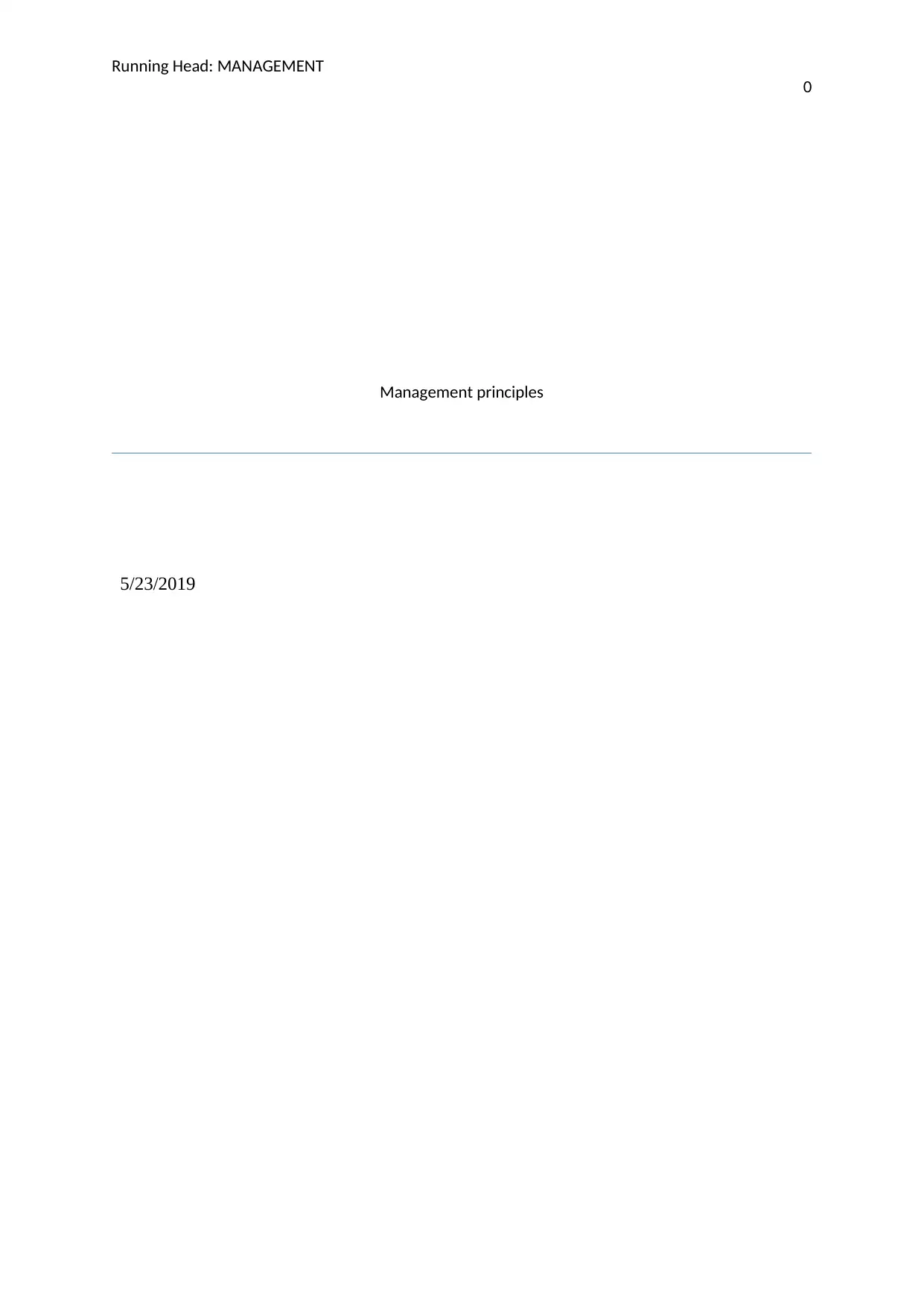
Running Head: MANAGEMENT
0
Management principles
5/23/2019
0
Management principles
5/23/2019
Paraphrase This Document
Need a fresh take? Get an instant paraphrase of this document with our AI Paraphraser
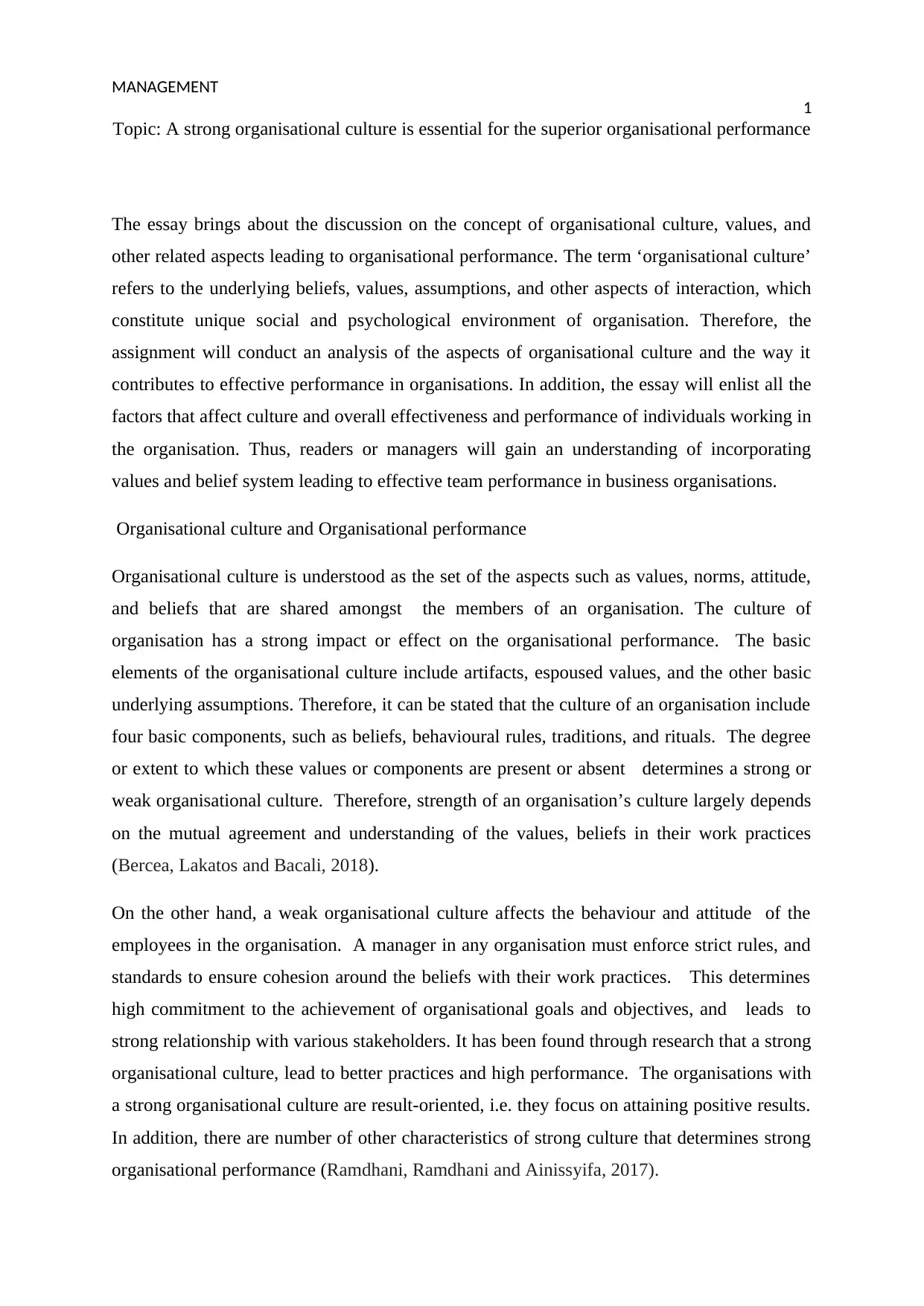
MANAGEMENT
1
Topic: A strong organisational culture is essential for the superior organisational performance
The essay brings about the discussion on the concept of organisational culture, values, and
other related aspects leading to organisational performance. The term ‘organisational culture’
refers to the underlying beliefs, values, assumptions, and other aspects of interaction, which
constitute unique social and psychological environment of organisation. Therefore, the
assignment will conduct an analysis of the aspects of organisational culture and the way it
contributes to effective performance in organisations. In addition, the essay will enlist all the
factors that affect culture and overall effectiveness and performance of individuals working in
the organisation. Thus, readers or managers will gain an understanding of incorporating
values and belief system leading to effective team performance in business organisations.
Organisational culture and Organisational performance
Organisational culture is understood as the set of the aspects such as values, norms, attitude,
and beliefs that are shared amongst the members of an organisation. The culture of
organisation has a strong impact or effect on the organisational performance. The basic
elements of the organisational culture include artifacts, espoused values, and the other basic
underlying assumptions. Therefore, it can be stated that the culture of an organisation include
four basic components, such as beliefs, behavioural rules, traditions, and rituals. The degree
or extent to which these values or components are present or absent determines a strong or
weak organisational culture. Therefore, strength of an organisation’s culture largely depends
on the mutual agreement and understanding of the values, beliefs in their work practices
(Bercea, Lakatos and Bacali, 2018).
On the other hand, a weak organisational culture affects the behaviour and attitude of the
employees in the organisation. A manager in any organisation must enforce strict rules, and
standards to ensure cohesion around the beliefs with their work practices. This determines
high commitment to the achievement of organisational goals and objectives, and leads to
strong relationship with various stakeholders. It has been found through research that a strong
organisational culture, lead to better practices and high performance. The organisations with
a strong organisational culture are result-oriented, i.e. they focus on attaining positive results.
In addition, there are number of other characteristics of strong culture that determines strong
organisational performance (Ramdhani, Ramdhani and Ainissyifa, 2017).
1
Topic: A strong organisational culture is essential for the superior organisational performance
The essay brings about the discussion on the concept of organisational culture, values, and
other related aspects leading to organisational performance. The term ‘organisational culture’
refers to the underlying beliefs, values, assumptions, and other aspects of interaction, which
constitute unique social and psychological environment of organisation. Therefore, the
assignment will conduct an analysis of the aspects of organisational culture and the way it
contributes to effective performance in organisations. In addition, the essay will enlist all the
factors that affect culture and overall effectiveness and performance of individuals working in
the organisation. Thus, readers or managers will gain an understanding of incorporating
values and belief system leading to effective team performance in business organisations.
Organisational culture and Organisational performance
Organisational culture is understood as the set of the aspects such as values, norms, attitude,
and beliefs that are shared amongst the members of an organisation. The culture of
organisation has a strong impact or effect on the organisational performance. The basic
elements of the organisational culture include artifacts, espoused values, and the other basic
underlying assumptions. Therefore, it can be stated that the culture of an organisation include
four basic components, such as beliefs, behavioural rules, traditions, and rituals. The degree
or extent to which these values or components are present or absent determines a strong or
weak organisational culture. Therefore, strength of an organisation’s culture largely depends
on the mutual agreement and understanding of the values, beliefs in their work practices
(Bercea, Lakatos and Bacali, 2018).
On the other hand, a weak organisational culture affects the behaviour and attitude of the
employees in the organisation. A manager in any organisation must enforce strict rules, and
standards to ensure cohesion around the beliefs with their work practices. This determines
high commitment to the achievement of organisational goals and objectives, and leads to
strong relationship with various stakeholders. It has been found through research that a strong
organisational culture, lead to better practices and high performance. The organisations with
a strong organisational culture are result-oriented, i.e. they focus on attaining positive results.
In addition, there are number of other characteristics of strong culture that determines strong
organisational performance (Ramdhani, Ramdhani and Ainissyifa, 2017).
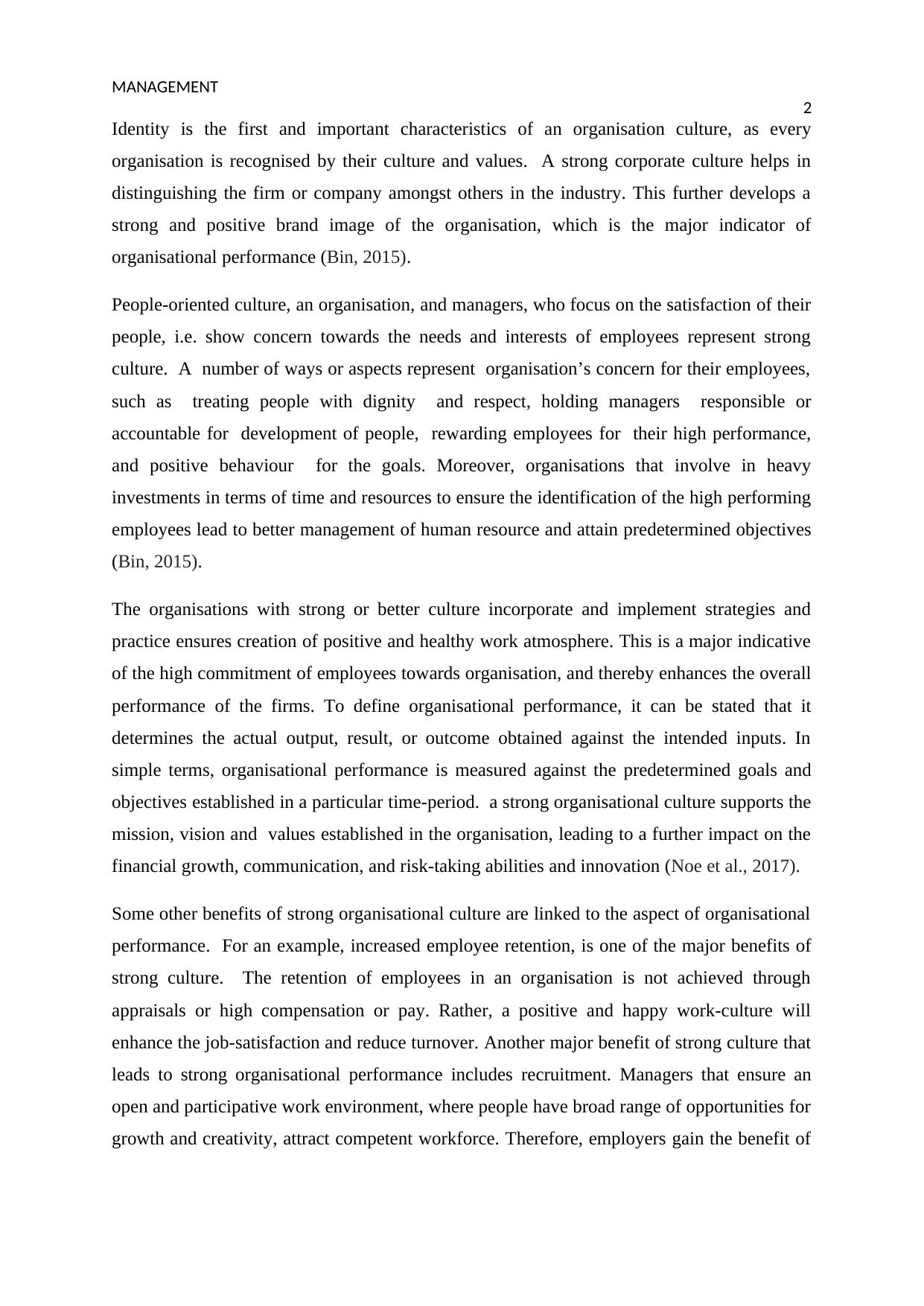
MANAGEMENT
2
Identity is the first and important characteristics of an organisation culture, as every
organisation is recognised by their culture and values. A strong corporate culture helps in
distinguishing the firm or company amongst others in the industry. This further develops a
strong and positive brand image of the organisation, which is the major indicator of
organisational performance (Bin, 2015).
People-oriented culture, an organisation, and managers, who focus on the satisfaction of their
people, i.e. show concern towards the needs and interests of employees represent strong
culture. A number of ways or aspects represent organisation’s concern for their employees,
such as treating people with dignity and respect, holding managers responsible or
accountable for development of people, rewarding employees for their high performance,
and positive behaviour for the goals. Moreover, organisations that involve in heavy
investments in terms of time and resources to ensure the identification of the high performing
employees lead to better management of human resource and attain predetermined objectives
(Bin, 2015).
The organisations with strong or better culture incorporate and implement strategies and
practice ensures creation of positive and healthy work atmosphere. This is a major indicative
of the high commitment of employees towards organisation, and thereby enhances the overall
performance of the firms. To define organisational performance, it can be stated that it
determines the actual output, result, or outcome obtained against the intended inputs. In
simple terms, organisational performance is measured against the predetermined goals and
objectives established in a particular time-period. a strong organisational culture supports the
mission, vision and values established in the organisation, leading to a further impact on the
financial growth, communication, and risk-taking abilities and innovation (Noe et al., 2017).
Some other benefits of strong organisational culture are linked to the aspect of organisational
performance. For an example, increased employee retention, is one of the major benefits of
strong culture. The retention of employees in an organisation is not achieved through
appraisals or high compensation or pay. Rather, a positive and happy work-culture will
enhance the job-satisfaction and reduce turnover. Another major benefit of strong culture that
leads to strong organisational performance includes recruitment. Managers that ensure an
open and participative work environment, where people have broad range of opportunities for
growth and creativity, attract competent workforce. Therefore, employers gain the benefit of
2
Identity is the first and important characteristics of an organisation culture, as every
organisation is recognised by their culture and values. A strong corporate culture helps in
distinguishing the firm or company amongst others in the industry. This further develops a
strong and positive brand image of the organisation, which is the major indicator of
organisational performance (Bin, 2015).
People-oriented culture, an organisation, and managers, who focus on the satisfaction of their
people, i.e. show concern towards the needs and interests of employees represent strong
culture. A number of ways or aspects represent organisation’s concern for their employees,
such as treating people with dignity and respect, holding managers responsible or
accountable for development of people, rewarding employees for their high performance,
and positive behaviour for the goals. Moreover, organisations that involve in heavy
investments in terms of time and resources to ensure the identification of the high performing
employees lead to better management of human resource and attain predetermined objectives
(Bin, 2015).
The organisations with strong or better culture incorporate and implement strategies and
practice ensures creation of positive and healthy work atmosphere. This is a major indicative
of the high commitment of employees towards organisation, and thereby enhances the overall
performance of the firms. To define organisational performance, it can be stated that it
determines the actual output, result, or outcome obtained against the intended inputs. In
simple terms, organisational performance is measured against the predetermined goals and
objectives established in a particular time-period. a strong organisational culture supports the
mission, vision and values established in the organisation, leading to a further impact on the
financial growth, communication, and risk-taking abilities and innovation (Noe et al., 2017).
Some other benefits of strong organisational culture are linked to the aspect of organisational
performance. For an example, increased employee retention, is one of the major benefits of
strong culture. The retention of employees in an organisation is not achieved through
appraisals or high compensation or pay. Rather, a positive and happy work-culture will
enhance the job-satisfaction and reduce turnover. Another major benefit of strong culture that
leads to strong organisational performance includes recruitment. Managers that ensure an
open and participative work environment, where people have broad range of opportunities for
growth and creativity, attract competent workforce. Therefore, employers gain the benefit of
⊘ This is a preview!⊘
Do you want full access?
Subscribe today to unlock all pages.

Trusted by 1+ million students worldwide
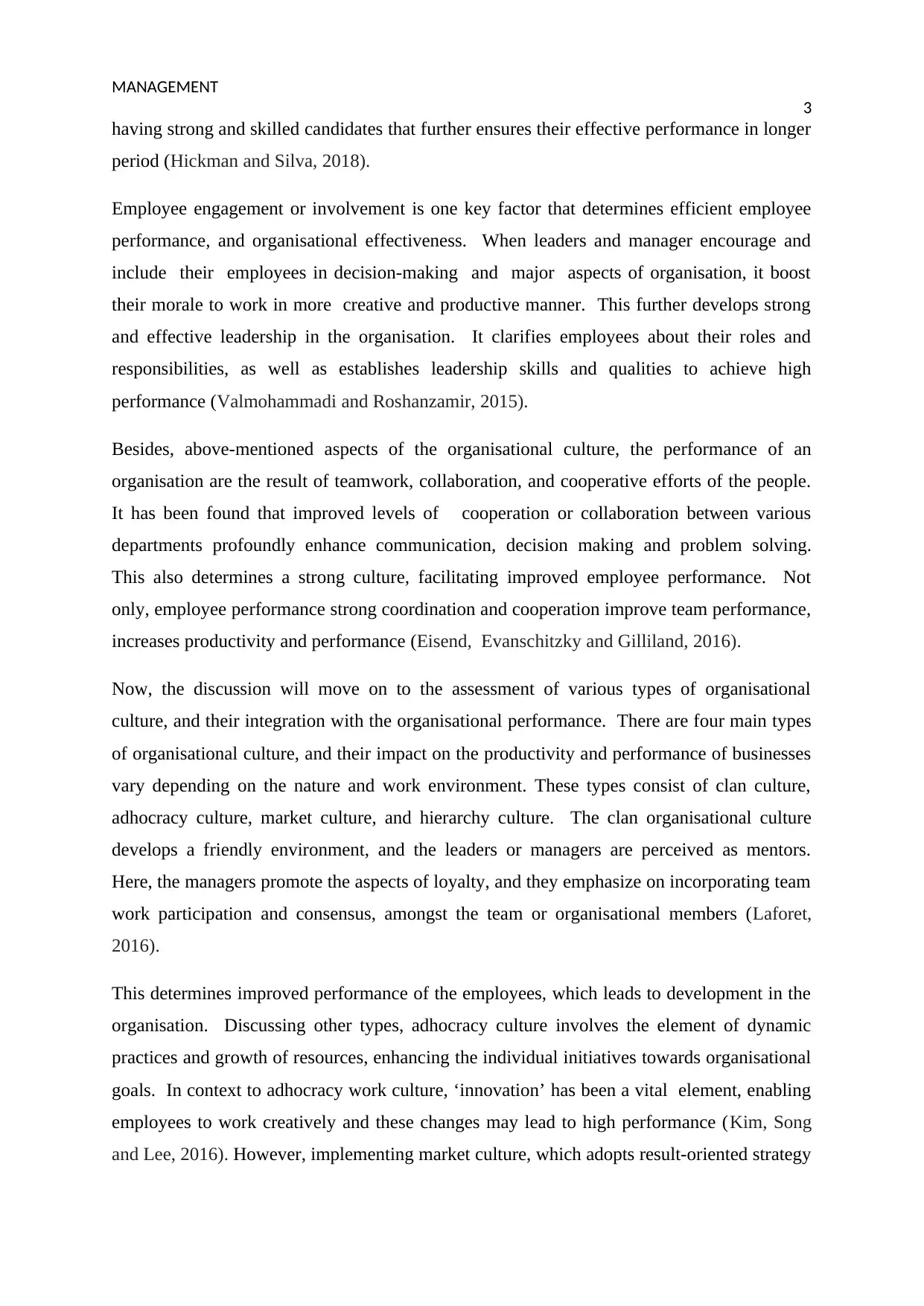
MANAGEMENT
3
having strong and skilled candidates that further ensures their effective performance in longer
period (Hickman and Silva, 2018).
Employee engagement or involvement is one key factor that determines efficient employee
performance, and organisational effectiveness. When leaders and manager encourage and
include their employees in decision-making and major aspects of organisation, it boost
their morale to work in more creative and productive manner. This further develops strong
and effective leadership in the organisation. It clarifies employees about their roles and
responsibilities, as well as establishes leadership skills and qualities to achieve high
performance (Valmohammadi and Roshanzamir, 2015).
Besides, above-mentioned aspects of the organisational culture, the performance of an
organisation are the result of teamwork, collaboration, and cooperative efforts of the people.
It has been found that improved levels of cooperation or collaboration between various
departments profoundly enhance communication, decision making and problem solving.
This also determines a strong culture, facilitating improved employee performance. Not
only, employee performance strong coordination and cooperation improve team performance,
increases productivity and performance (Eisend, Evanschitzky and Gilliland, 2016).
Now, the discussion will move on to the assessment of various types of organisational
culture, and their integration with the organisational performance. There are four main types
of organisational culture, and their impact on the productivity and performance of businesses
vary depending on the nature and work environment. These types consist of clan culture,
adhocracy culture, market culture, and hierarchy culture. The clan organisational culture
develops a friendly environment, and the leaders or managers are perceived as mentors.
Here, the managers promote the aspects of loyalty, and they emphasize on incorporating team
work participation and consensus, amongst the team or organisational members (Laforet,
2016).
This determines improved performance of the employees, which leads to development in the
organisation. Discussing other types, adhocracy culture involves the element of dynamic
practices and growth of resources, enhancing the individual initiatives towards organisational
goals. In context to adhocracy work culture, ‘innovation’ has been a vital element, enabling
employees to work creatively and these changes may lead to high performance (Kim, Song
and Lee, 2016). However, implementing market culture, which adopts result-oriented strategy
3
having strong and skilled candidates that further ensures their effective performance in longer
period (Hickman and Silva, 2018).
Employee engagement or involvement is one key factor that determines efficient employee
performance, and organisational effectiveness. When leaders and manager encourage and
include their employees in decision-making and major aspects of organisation, it boost
their morale to work in more creative and productive manner. This further develops strong
and effective leadership in the organisation. It clarifies employees about their roles and
responsibilities, as well as establishes leadership skills and qualities to achieve high
performance (Valmohammadi and Roshanzamir, 2015).
Besides, above-mentioned aspects of the organisational culture, the performance of an
organisation are the result of teamwork, collaboration, and cooperative efforts of the people.
It has been found that improved levels of cooperation or collaboration between various
departments profoundly enhance communication, decision making and problem solving.
This also determines a strong culture, facilitating improved employee performance. Not
only, employee performance strong coordination and cooperation improve team performance,
increases productivity and performance (Eisend, Evanschitzky and Gilliland, 2016).
Now, the discussion will move on to the assessment of various types of organisational
culture, and their integration with the organisational performance. There are four main types
of organisational culture, and their impact on the productivity and performance of businesses
vary depending on the nature and work environment. These types consist of clan culture,
adhocracy culture, market culture, and hierarchy culture. The clan organisational culture
develops a friendly environment, and the leaders or managers are perceived as mentors.
Here, the managers promote the aspects of loyalty, and they emphasize on incorporating team
work participation and consensus, amongst the team or organisational members (Laforet,
2016).
This determines improved performance of the employees, which leads to development in the
organisation. Discussing other types, adhocracy culture involves the element of dynamic
practices and growth of resources, enhancing the individual initiatives towards organisational
goals. In context to adhocracy work culture, ‘innovation’ has been a vital element, enabling
employees to work creatively and these changes may lead to high performance (Kim, Song
and Lee, 2016). However, implementing market culture, which adopts result-oriented strategy
Paraphrase This Document
Need a fresh take? Get an instant paraphrase of this document with our AI Paraphraser
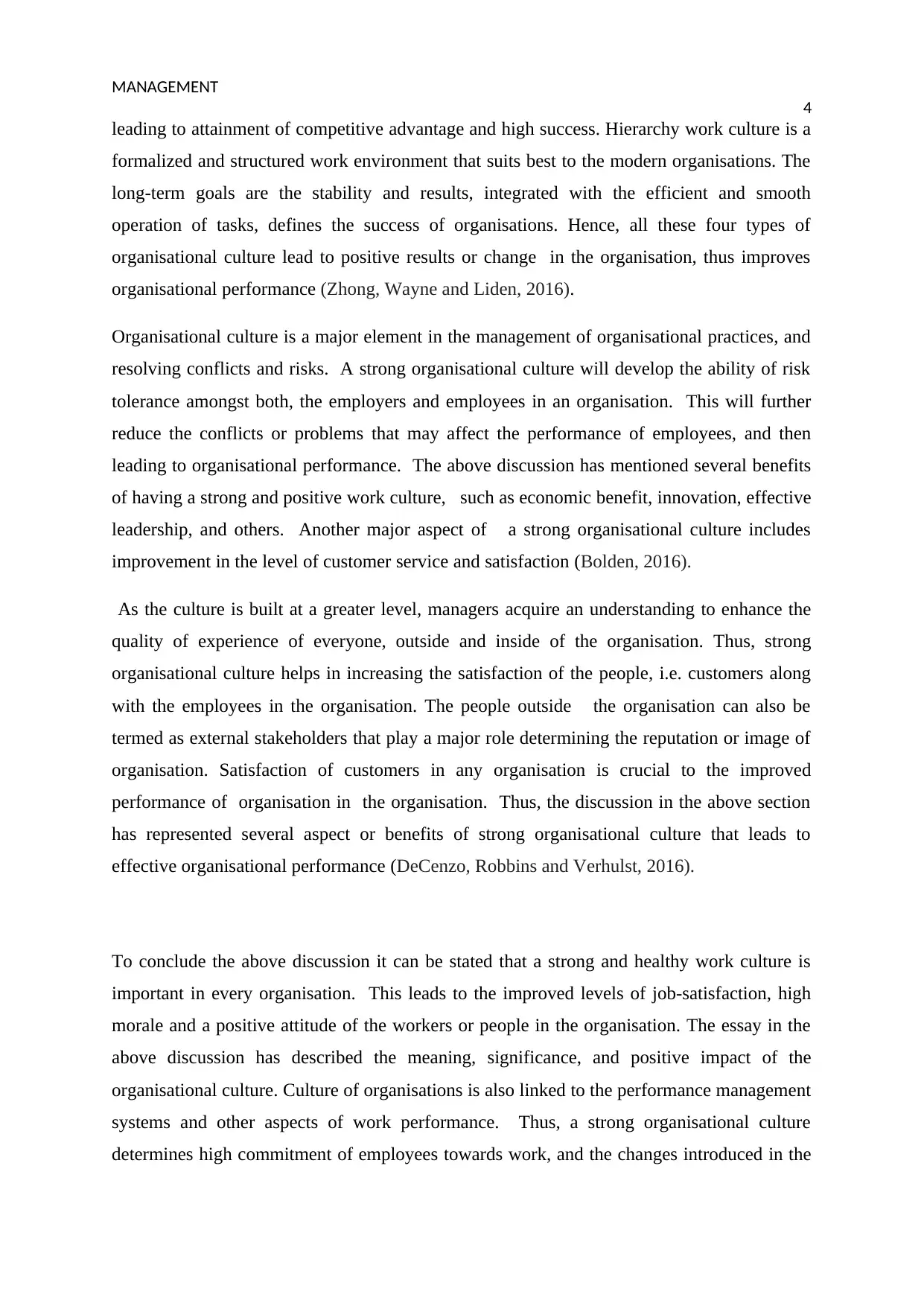
MANAGEMENT
4
leading to attainment of competitive advantage and high success. Hierarchy work culture is a
formalized and structured work environment that suits best to the modern organisations. The
long-term goals are the stability and results, integrated with the efficient and smooth
operation of tasks, defines the success of organisations. Hence, all these four types of
organisational culture lead to positive results or change in the organisation, thus improves
organisational performance (Zhong, Wayne and Liden, 2016).
Organisational culture is a major element in the management of organisational practices, and
resolving conflicts and risks. A strong organisational culture will develop the ability of risk
tolerance amongst both, the employers and employees in an organisation. This will further
reduce the conflicts or problems that may affect the performance of employees, and then
leading to organisational performance. The above discussion has mentioned several benefits
of having a strong and positive work culture, such as economic benefit, innovation, effective
leadership, and others. Another major aspect of a strong organisational culture includes
improvement in the level of customer service and satisfaction (Bolden, 2016).
As the culture is built at a greater level, managers acquire an understanding to enhance the
quality of experience of everyone, outside and inside of the organisation. Thus, strong
organisational culture helps in increasing the satisfaction of the people, i.e. customers along
with the employees in the organisation. The people outside the organisation can also be
termed as external stakeholders that play a major role determining the reputation or image of
organisation. Satisfaction of customers in any organisation is crucial to the improved
performance of organisation in the organisation. Thus, the discussion in the above section
has represented several aspect or benefits of strong organisational culture that leads to
effective organisational performance (DeCenzo, Robbins and Verhulst, 2016).
To conclude the above discussion it can be stated that a strong and healthy work culture is
important in every organisation. This leads to the improved levels of job-satisfaction, high
morale and a positive attitude of the workers or people in the organisation. The essay in the
above discussion has described the meaning, significance, and positive impact of the
organisational culture. Culture of organisations is also linked to the performance management
systems and other aspects of work performance. Thus, a strong organisational culture
determines high commitment of employees towards work, and the changes introduced in the
4
leading to attainment of competitive advantage and high success. Hierarchy work culture is a
formalized and structured work environment that suits best to the modern organisations. The
long-term goals are the stability and results, integrated with the efficient and smooth
operation of tasks, defines the success of organisations. Hence, all these four types of
organisational culture lead to positive results or change in the organisation, thus improves
organisational performance (Zhong, Wayne and Liden, 2016).
Organisational culture is a major element in the management of organisational practices, and
resolving conflicts and risks. A strong organisational culture will develop the ability of risk
tolerance amongst both, the employers and employees in an organisation. This will further
reduce the conflicts or problems that may affect the performance of employees, and then
leading to organisational performance. The above discussion has mentioned several benefits
of having a strong and positive work culture, such as economic benefit, innovation, effective
leadership, and others. Another major aspect of a strong organisational culture includes
improvement in the level of customer service and satisfaction (Bolden, 2016).
As the culture is built at a greater level, managers acquire an understanding to enhance the
quality of experience of everyone, outside and inside of the organisation. Thus, strong
organisational culture helps in increasing the satisfaction of the people, i.e. customers along
with the employees in the organisation. The people outside the organisation can also be
termed as external stakeholders that play a major role determining the reputation or image of
organisation. Satisfaction of customers in any organisation is crucial to the improved
performance of organisation in the organisation. Thus, the discussion in the above section
has represented several aspect or benefits of strong organisational culture that leads to
effective organisational performance (DeCenzo, Robbins and Verhulst, 2016).
To conclude the above discussion it can be stated that a strong and healthy work culture is
important in every organisation. This leads to the improved levels of job-satisfaction, high
morale and a positive attitude of the workers or people in the organisation. The essay in the
above discussion has described the meaning, significance, and positive impact of the
organisational culture. Culture of organisations is also linked to the performance management
systems and other aspects of work performance. Thus, a strong organisational culture
determines high commitment of employees towards work, and the changes introduced in the
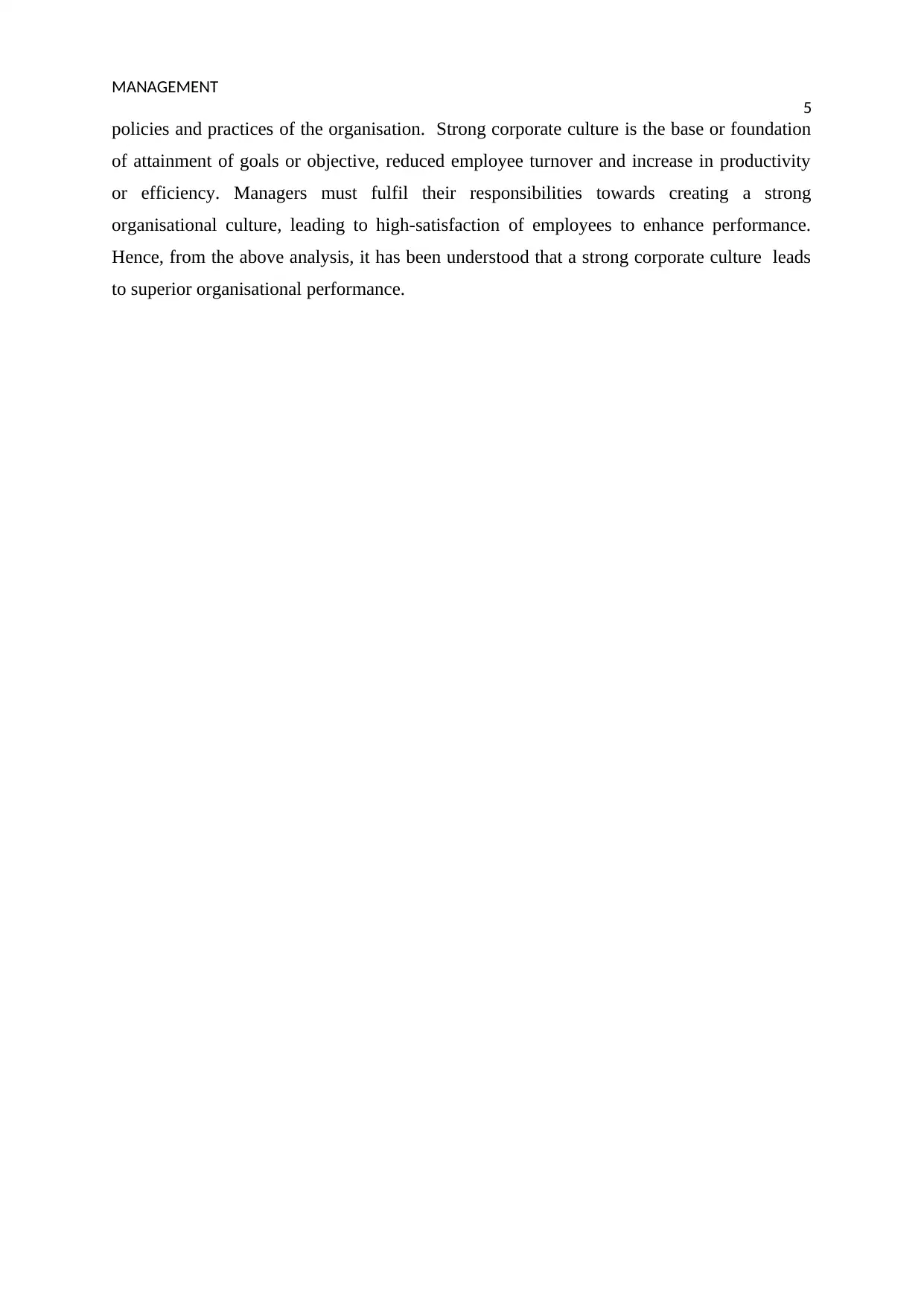
MANAGEMENT
5
policies and practices of the organisation. Strong corporate culture is the base or foundation
of attainment of goals or objective, reduced employee turnover and increase in productivity
or efficiency. Managers must fulfil their responsibilities towards creating a strong
organisational culture, leading to high-satisfaction of employees to enhance performance.
Hence, from the above analysis, it has been understood that a strong corporate culture leads
to superior organisational performance.
5
policies and practices of the organisation. Strong corporate culture is the base or foundation
of attainment of goals or objective, reduced employee turnover and increase in productivity
or efficiency. Managers must fulfil their responsibilities towards creating a strong
organisational culture, leading to high-satisfaction of employees to enhance performance.
Hence, from the above analysis, it has been understood that a strong corporate culture leads
to superior organisational performance.
⊘ This is a preview!⊘
Do you want full access?
Subscribe today to unlock all pages.

Trusted by 1+ million students worldwide
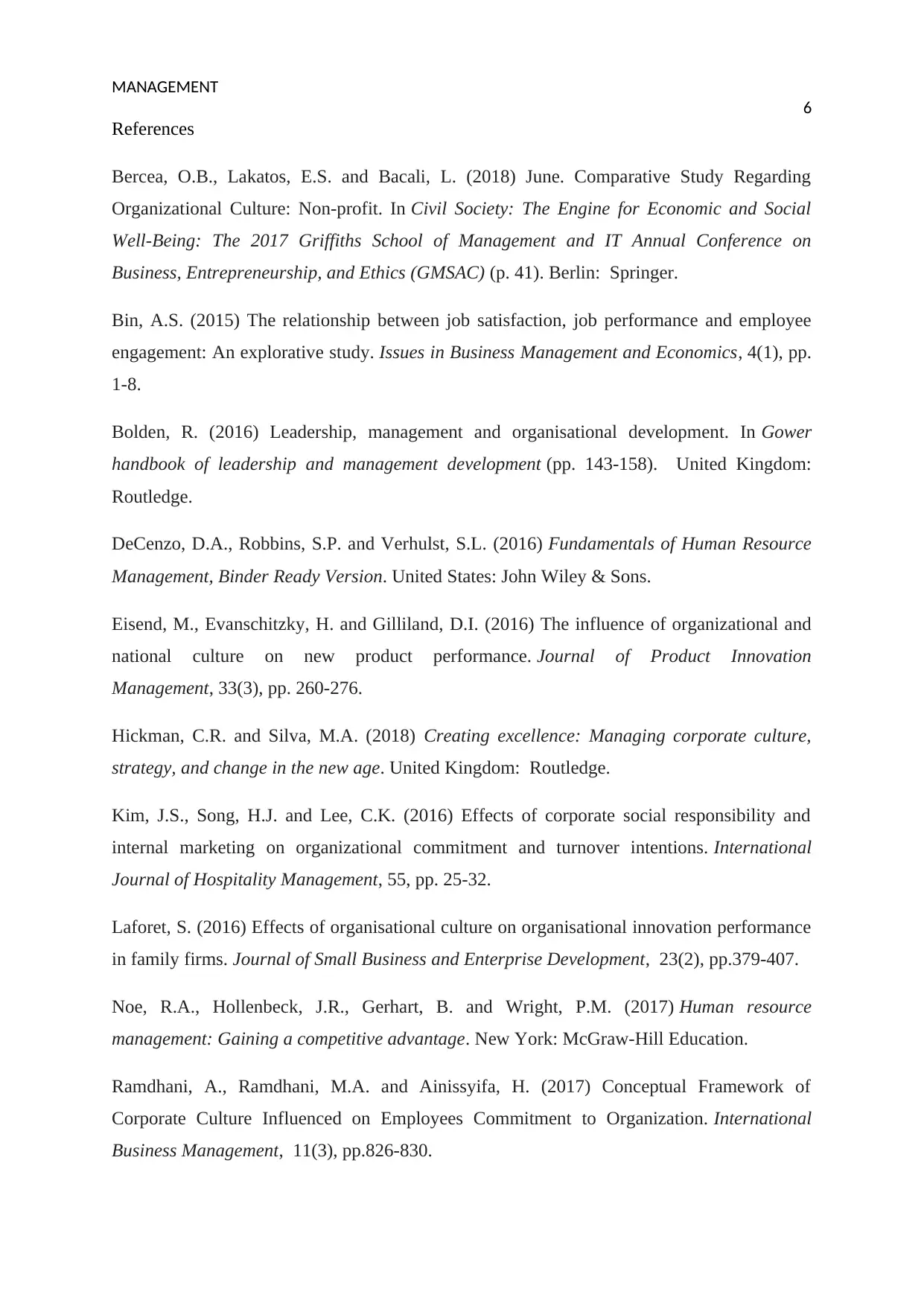
MANAGEMENT
6
References
Bercea, O.B., Lakatos, E.S. and Bacali, L. (2018) June. Comparative Study Regarding
Organizational Culture: Non-profit. In Civil Society: The Engine for Economic and Social
Well-Being: The 2017 Griffiths School of Management and IT Annual Conference on
Business, Entrepreneurship, and Ethics (GMSAC) (p. 41). Berlin: Springer.
Bin, A.S. (2015) The relationship between job satisfaction, job performance and employee
engagement: An explorative study. Issues in Business Management and Economics, 4(1), pp.
1-8.
Bolden, R. (2016) Leadership, management and organisational development. In Gower
handbook of leadership and management development (pp. 143-158). United Kingdom:
Routledge.
DeCenzo, D.A., Robbins, S.P. and Verhulst, S.L. (2016) Fundamentals of Human Resource
Management, Binder Ready Version. United States: John Wiley & Sons.
Eisend, M., Evanschitzky, H. and Gilliland, D.I. (2016) The influence of organizational and
national culture on new product performance. Journal of Product Innovation
Management, 33(3), pp. 260-276.
Hickman, C.R. and Silva, M.A. (2018) Creating excellence: Managing corporate culture,
strategy, and change in the new age. United Kingdom: Routledge.
Kim, J.S., Song, H.J. and Lee, C.K. (2016) Effects of corporate social responsibility and
internal marketing on organizational commitment and turnover intentions. International
Journal of Hospitality Management, 55, pp. 25-32.
Laforet, S. (2016) Effects of organisational culture on organisational innovation performance
in family firms. Journal of Small Business and Enterprise Development, 23(2), pp.379-407.
Noe, R.A., Hollenbeck, J.R., Gerhart, B. and Wright, P.M. (2017) Human resource
management: Gaining a competitive advantage. New York: McGraw-Hill Education.
Ramdhani, A., Ramdhani, M.A. and Ainissyifa, H. (2017) Conceptual Framework of
Corporate Culture Influenced on Employees Commitment to Organization. International
Business Management, 11(3), pp.826-830.
6
References
Bercea, O.B., Lakatos, E.S. and Bacali, L. (2018) June. Comparative Study Regarding
Organizational Culture: Non-profit. In Civil Society: The Engine for Economic and Social
Well-Being: The 2017 Griffiths School of Management and IT Annual Conference on
Business, Entrepreneurship, and Ethics (GMSAC) (p. 41). Berlin: Springer.
Bin, A.S. (2015) The relationship between job satisfaction, job performance and employee
engagement: An explorative study. Issues in Business Management and Economics, 4(1), pp.
1-8.
Bolden, R. (2016) Leadership, management and organisational development. In Gower
handbook of leadership and management development (pp. 143-158). United Kingdom:
Routledge.
DeCenzo, D.A., Robbins, S.P. and Verhulst, S.L. (2016) Fundamentals of Human Resource
Management, Binder Ready Version. United States: John Wiley & Sons.
Eisend, M., Evanschitzky, H. and Gilliland, D.I. (2016) The influence of organizational and
national culture on new product performance. Journal of Product Innovation
Management, 33(3), pp. 260-276.
Hickman, C.R. and Silva, M.A. (2018) Creating excellence: Managing corporate culture,
strategy, and change in the new age. United Kingdom: Routledge.
Kim, J.S., Song, H.J. and Lee, C.K. (2016) Effects of corporate social responsibility and
internal marketing on organizational commitment and turnover intentions. International
Journal of Hospitality Management, 55, pp. 25-32.
Laforet, S. (2016) Effects of organisational culture on organisational innovation performance
in family firms. Journal of Small Business and Enterprise Development, 23(2), pp.379-407.
Noe, R.A., Hollenbeck, J.R., Gerhart, B. and Wright, P.M. (2017) Human resource
management: Gaining a competitive advantage. New York: McGraw-Hill Education.
Ramdhani, A., Ramdhani, M.A. and Ainissyifa, H. (2017) Conceptual Framework of
Corporate Culture Influenced on Employees Commitment to Organization. International
Business Management, 11(3), pp.826-830.
Paraphrase This Document
Need a fresh take? Get an instant paraphrase of this document with our AI Paraphraser
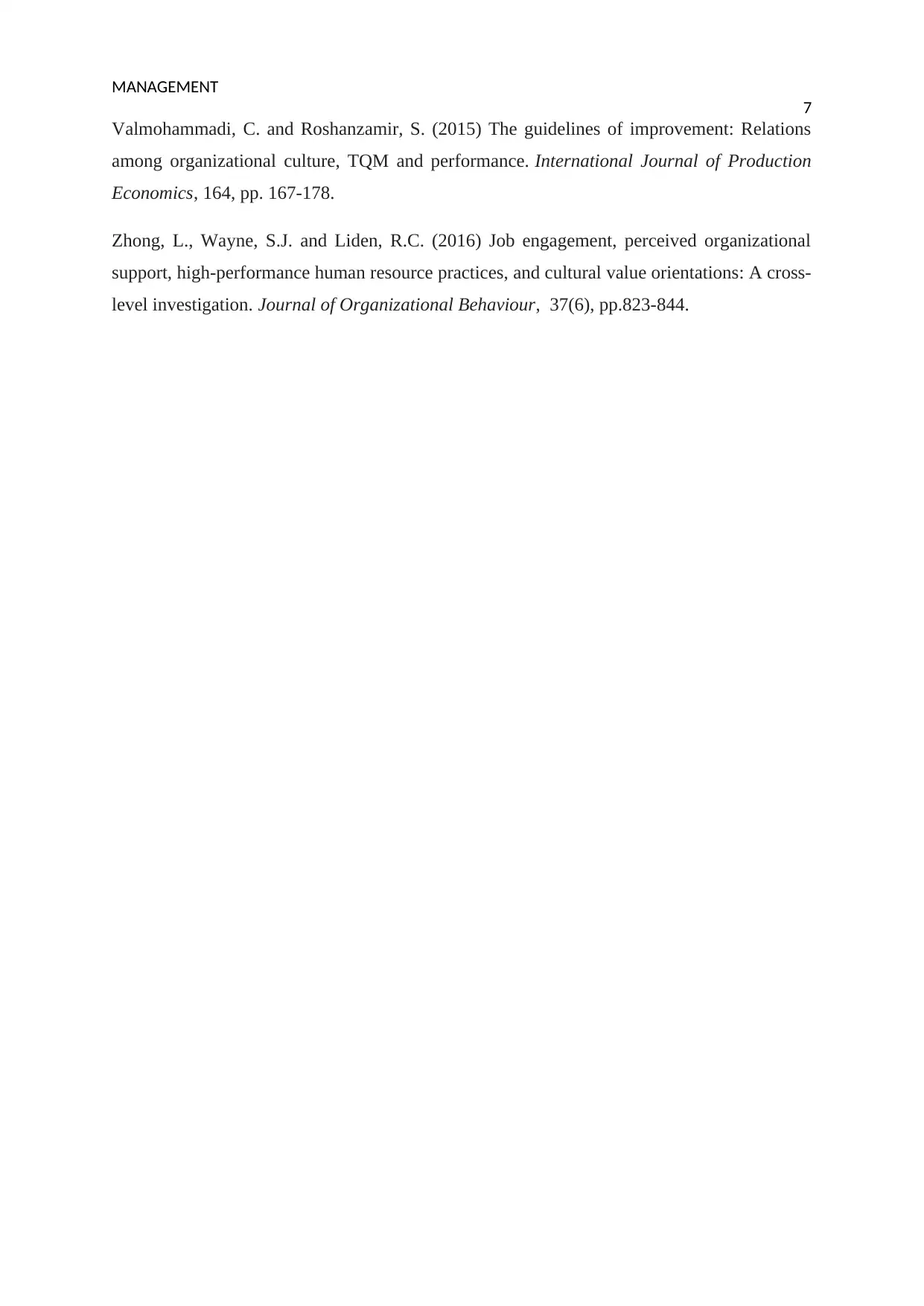
MANAGEMENT
7
Valmohammadi, C. and Roshanzamir, S. (2015) The guidelines of improvement: Relations
among organizational culture, TQM and performance. International Journal of Production
Economics, 164, pp. 167-178.
Zhong, L., Wayne, S.J. and Liden, R.C. (2016) Job engagement, perceived organizational
support, high‐performance human resource practices, and cultural value orientations: A cross‐
level investigation. Journal of Organizational Behaviour, 37(6), pp.823-844.
7
Valmohammadi, C. and Roshanzamir, S. (2015) The guidelines of improvement: Relations
among organizational culture, TQM and performance. International Journal of Production
Economics, 164, pp. 167-178.
Zhong, L., Wayne, S.J. and Liden, R.C. (2016) Job engagement, perceived organizational
support, high‐performance human resource practices, and cultural value orientations: A cross‐
level investigation. Journal of Organizational Behaviour, 37(6), pp.823-844.
1 out of 8
Related Documents
Your All-in-One AI-Powered Toolkit for Academic Success.
+13062052269
info@desklib.com
Available 24*7 on WhatsApp / Email
![[object Object]](/_next/static/media/star-bottom.7253800d.svg)
Unlock your academic potential
Copyright © 2020–2025 A2Z Services. All Rights Reserved. Developed and managed by ZUCOL.





